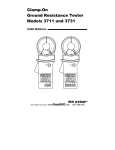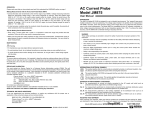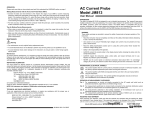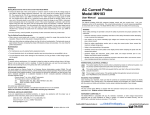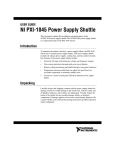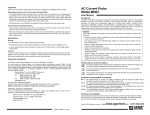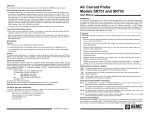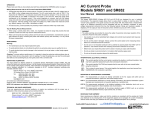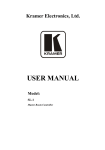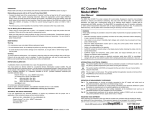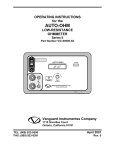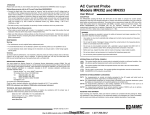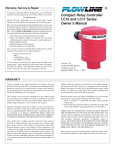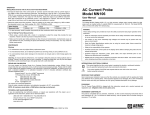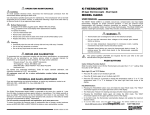Download AEMC Instruments AEMC MD305 Current
Transcript
OPERATION Please make sure that you have already read and fully understand the WARNING section on page 1. Making Measurements with the AC Current Probe Model MD305 • Connect the black and red terminals to the Ampere AC range of your DMM or current measuring instrument. Select the appropriate current range (2A AC range). Clamp the probe around the conductor to be tested with the arrow pointed toward the load. If the reading is less than 200mA, select the lower range until you obtain the best resolution. Read the value display on the DMM and multiply it by the probe ratio (1000/1). (If reading = 0.459A, the current flowing through the probe is 0.459A x 1000 = 459A AC). • For best accuracy, avoid if possible, the proximity of other conductors which may create noise. Tips for Making Precise Measurements • When using a current probe with a meter, it is important to select the range that provides the best resolution. Failure to do this may result in measurement errors. AC Current Probe Model MD305 User Manual DESCRIPTION The MD305 (Catalog #1201.36) is designed for use in industrial environments. The hook-shaped jaws enable the user to “pry” into or “hook” onto cables (will accept 2 x 500 MCM) or even smaller bus bars. compatible with any AC Ammeter, multimeter, or other current measurement instruments with an input impedance lower than 5Ω. To achieve the stated accuracy, use the MD305 with an Ammeter having an accuracy of 0.75% or better. WARNING • Make sure that probe jaw mating surfaces are free of dust and contamination. Contaminants cause air gaps between the jaws, increasing the phase shift between primary and secondary. It is very critical for power measurement. These safety warnings are provided to ensure the safety of personnel and proper operation of the instrument. MAINTENANCE: • Use caution on any circuit: Potentially high voltages and currents may be present and may pose a shock hazard. Warning • For maintenance use only original replacement parts. • To avoid electrical shock, do not attempt to perform any servicing unless you are qualified to do so. • To avoid electrical shock and/or damage to the instrument, do not get water or other foreign agents into the probe. Cleaning To ensure optimum performance, it is important to keep the probe jaw mating surfaces clean at all times. Failure to do so may result in error in readings. To clean the probe jaws, use very fine sand paper (fine 600) to avoid scratching the jaw, then gently clean with a soft, oiled cloth. REPAIR AND CALIBRATION You must contact our Service Center for a Customer Service Authorization number (CSA#). This will ensure that when your instrument arrives, it will be tracked and processed promptly. Please write the CSA# on the outside of the shipping container. If the instrument is returned for calibration, we need to know if you want a standard calibration, or a calibration traceable to N.I.S.T. (includes calibration certificate plus recorded calibration data). Chauvin Arnoux®, Inc. d.b.a. AEMC® Instruments 15 Faraday Drive • Dover, NH 03820 USA Tel: (800) 945-2362 (Ext. 360) (603) 749-6434 (Ext. 360) Fax: (603) 742-2346 [email protected] (Or contact your authorized distributor) Costs for repair, standard calibration, and calibration traceable to N.I.S.T. are available. NOTE: All customers must obtain a CSA# before returning any instrument. TECHNICAL AND SALES ASSISTANCE If you are experiencing any technical problems, or require any assistance with the proper use or application of this instrument, please call our technical hotline: (800) 343-1391 • (508) 698-2115 • Fax (508) 698-2118 Chauvin Arnoux®, Inc. d.b.a. AEMC® Instruments [email protected] www.aemc.com • Read the instruction manual completely and follow all the safety information before attempting to use or service this instrument. • Read the Safety Specifications section prior to using the current probe. Never exceed the maximum voltage ratings given. • Safety is the responsibility of the operator. • ALWAYS connect the current probe to the display device before clamping the probe onto the sample being tested. • ALWAYS inspect the instrument, probe, probe cable, and output terminals prior to use. Replace any defective parts immediately. • NEVER use the current probe on electrical conductors rated above 600V in overvoltage category III (CAT III). Use extreme caution when clamping around bare conductors or bus bars. INTERNATIONAL ELECTRICAL SYMBOLS This symbol signifies that the current probe is protected by double or reinforced insulation. Use only factory specified replacement parts when servicing the instrument. This symbol signifies CAUTION! and requests that the user refer to the user manual before using the instrument. This is a type A current sensor. This symbol signifies that application around and removal from HAZARDOUS LIVE conductors is permitted. DEFINITION OF MEASUREMENT CATEGORIES Cat. I: For measurements on circuits not directly connected to the AC supply wall outlet such as protected secondaries, signal level, and limited energy circuits. Cat. II: For measurements performed on circuits directly connected to the electrical distribution system. Examples are measurements on household appliances or portable tools. Cat. III: For measurements performed in the building installation at the distribution level such as on hardwired equipment in fixed installation and circuit breakers. Cat. IV: For measurements performed at the primary electrical supply (<1000V) such as on primary overcurrent protection devices, ripple control units, or meters. RECEIVING YOUR SHIPMENT Upon receiving your shipment, make sure that the contents are consistent with the packing list. Notify your distributor of any missing items. If the equipment appears to be damaged, file a claim immediately with the carrier and notify your distributor at once, giving a detailed description of any damage. Shop for AEMC products online at: 99-MAN 100120.v5 05/07 www.ShopAEMC.com 1.877.766.5412 Ø =1.18" (30 mm) Cable max. 2.5 x 0.19" (63 x 5 mm) Bus Bar max. Ø =0.98" (25 mm) Dual Cable max. Frequency Range: 40 to 1000Hz (error: add 2% to ref.) Vibration: 10/55/10 Hz, 0.15mm (IEC 68-2-6) Load Impedance: 5Ω max non-inductive Polycarbonate Material: Handles: 10% fiberglass charged polycarbonate UL 94 V0 Open Secondary Voltage: Limited to 10V peak max. Working Voltage: 600Vrms Common Mode Voltage: 600Vrms I Influence of Adjacent Parallel Conductor: < 30mA/A at 50Hz 7.68" (195 mm) Influence of Conductor in Jaw Opening: < 1% Dimensions: 2.6 x 7.68 x 1.34" (66 x 195 x 34mm) Weight: 14.82 oz (420g) Colors: Dark gray handles Output: Double insulated 5 ft (1.5m) lead with safety banana plugs SAFETY SPECIFICATIONS Operating Temperature: -5° to 122°F (-15° to 50°C) Black S1 S2 MECHANICAL SPECIFICATIONS Red Influence of Temperature: < 0.1% per 10°K 1.34" (34 mm) 2.6" (66 mm) Storage Temperature: -40° to 185°F (-40° to 85°C) Altitude: Operating: 0 to 2000m Non-operating: 0 to 12,000m Jaw Opening: 1.3" (33mm) ELECTRICAL SPECIFICATIONS Maximum Conductor Size: 1.18” (30mm) Accuracy*: Current Range: 1 to 600A AC Transformation Ratio: 1000:1 Output Signal: 1mA AC/A AC Overload: 700A for 10mn Shop for AEMC products online at: Primary current Accuracy % Phase shift 25A 3% 3° 100A 1.5% 1.5° 250A; 500A 1% 1° 600A 2% 1° 600A for 20 mn max (*Reference conditions: 23°C ± 5°K, 20 to 75% RH, external magnetic field < 40 A/m, no DC component, no external current carrying conductor, test sample centered.) 5Ω load. www.ShopAEMC.com 1.877.766.5412 Maximum Bus Bar Size: 2.48 x 0.20” (63 x 5mm) Envelope Protection: IP 20 (IEC 529) Drop Test: 1.5m (IEC 68-2-32) Mechanical Shock: 100g (IEC 68-2-27) Electrical: Double insulation or reinforced insulation between the primary or secondary and the outer case of the handle conforms to IEC 1010-2-32. Common Mode Voltage: 600V Category III, Pollution Degree 2 Electromagnetic Compatibility: EN 50081-1 Class B EN 50082-2 Electrostatic discharge IEC 1000-4-2 Radiated field IEC 1000-4-3 Fast transients IEC 1000-4-4 Magnetic field at 50/60 Hz IEC 1000-4-8 ORDERING INFORMATION Current Probe MD305...................Cat #1201.36 Includes a user manual and a product warranty and registration card Accessories: Banana plug adapter (to non-recessed plug) ...................Cat #1017.45 Ø =1.18" (30 mm) Cable max. 2.5 x 0.19" (63 x 5 mm) Bus Bar max. Ø =0.98" (25 mm) Dual Cable max. Frequency Range: 40 to 1000Hz (error: add 2% to ref.) Vibration: 10/55/10 Hz, 0.15mm (IEC 68-2-6) Load Impedance: 5Ω max noninductive Polycarbonate Material: Handles: 10% fiberglass charged polycarbonate UL 94 V0 Open Secondary Voltage: Limited to 10V peak max. Dimensions: 2.6 x 7.68 x 1.34" (66 x 195 x 34mm) Working Voltage: 600Vrms Weight: 14.82 oz (420g) Common Mode Voltage: 600Vrms I Influence of Adjacent Parallel Conductor: < 30mA/A at 50Hz 7.68" (195 mm) Influence of Conductor in Jaw Opening: < 1% Colors: Dark gray handles Output: Double insulated 5 ft (1.5m) lead with safety banana plugs SAFETY SPECIFICATIONS Operating Temperature: -5° to 122°F (-15° to 50°C) Black S1 S2 MECHANICAL SPECIFICATIONS Red 2.6" (66 mm) Storage Temperature: -40° to 185°F (-40° to 85°C) Influence of Temperature: < 0.1% per 10°K 1.34" (34 mm) Altitude: Operating: 0 to 2000m Non-operating: 0 to 12,000m Jaw Opening: 1.3" (33mm) ELECTRICAL SPECIFICATIONS Maximum Conductor Size: 1.18” (30mm) Accuracy*: Current Range: 1 to 600A AC Transformation Ratio: 1000:1 Output Signal: 1mA AC/A AC Overload: 700A for 10mn Primary current Accuracy % Phase shift 25A 3% 3° 100A 1.5% 1.5° 250A; 500A 1% 1° 600A 1% 1° 600A for 20 mn max (*Reference conditions: 23°C ± 5°K, 20 to 75% RH, external magnetic field < 40 A/m, no DC component, no external current carrying conductor, test sample centered.) 5Ω load. Maximum Bus Bar Size: 2.48 x 0.20” (63 x 5mm) Envelope Protection: IP 20 (IEC 529) Drop Test: 1.5m (IEC 68-2-32) Mechanical Shock: 100g (IEC 68-2-27) Shop for AEMC products online at: Electrical: Double insulation or reinforced insulation between the primary or secondary and the outer case of the handle conforms to IEC 1010-2-32. Common Mode Voltage: 600V Category III, Pollution Degree 2 Electromagnetic Compatibility: EN 50081-1 Class B EN 50082-2 Electrostatic discharge IEC 1000-4-2 Radiated field IEC 1000-4-3 Fast transients IEC 1000-4-4 Magnetic field at 50/60 Hz IEC 1000-4-8 ORDERING INFORMATION Current Probe MD305...................Cat #1201.36 Includes a user manual and a product warranty and registration card Accessories: Banana plug adapter (to nonrecessed plug) ....................Cat #1017.45 www.ShopAEMC.com 1.877.766.5412 OPERATION Please make sure that you have already read and fully understand the WARNING section on page 1. Making Measurements with the AC Current Probe Model MD305 • Connect the black and red terminals to the Ampere AC range of your DMM or current measuring instrument. Select the appropriate current range (2A AC range). Clamp the probe around the conductor to be tested with the arrow pointed toward the load. If the reading is less than 200mA, select the lower range until you obtain the best resolution. Read the value display on the DMM and multiply it by the probe ratio (1000/1). (If reading = 0.459A, the current flowing through the probe is 0.459A x 1000 = 459A AC). • For best accuracy, avoid if possible, the proximity of other conductors which may create noise. Tips for Making Precise Measurements • When using a current probe with a meter, it is important to select the range that provides the best resolution. Failure to do this may result in measurement errors. AC Current Probe Model MD305 User Manual DESCRIPTION The MD305 (Catalog #1201.36) is designed for use in industrial environments. The hook-shaped jaws enable the user to “pry” into or “hook” onto cables (will accept 2 x 500 MCM) or even smaller bus bars. compatible with any AC Ammeter, multimeter, or other current measurement instruments with an input impedance lower than 5Ω. To achieve the stated accuracy, use the MD305 with an Ammeter having an accuracy of 0.75% or better. WARNING • Make sure that probe jaw mating surfaces are free of dust and contamination. Contaminants cause air gaps between the jaws, increasing the phase shift between primary and secondary. It is very critical for power measurement. These safety warnings are provided to ensure the safety of personnel and proper operation of the instrument. MAINTENANCE: • Use caution on any circuit: Potentially high voltages and currents may be present and may pose a shock hazard. Warning • For maintenance use only original replacement parts. • To avoid electrical shock, do not attempt to perform any servicing unless you are qualified to do so. • To avoid electrical shock and/or damage to the instrument, do not get water or other foreign agents into the probe. Cleaning To ensure optimum performance, it is important to keep the probe jaw mating surfaces clean at all times. Failure to do so may result in error in readings. To clean the probe jaws, use very fine sand paper (fine 600) to avoid scratching the jaw, then gently clean with a soft, oiled cloth. REPAIR AND CALIBRATION You must contact our Service Center for a Customer Service Authorization number (CSA#). This will ensure that when your instrument arrives, it will be tracked and processed promptly. Please write the CSA# on the outside of the shipping container. If the instrument is returned for calibration, we need to know if you want a standard calibration, or a calibration traceable to N.I.S.T. (includes calibration certificate plus recorded calibration data). Chauvin Arnoux®, Inc. d.b.a. AEMC® Instruments 15 Faraday Drive • Dover, NH 03820 USA Tel: (800) 945-2362 (Ext. 360) (603) 749-6434 (Ext. 360) Fax: (603) 742-2346 [email protected] (Or contact your authorized distributor) Costs for repair, standard calibration, and calibration traceable to N.I.S.T. are available. NOTE: All customers must obtain a CSA# before returning any instrument. TECHNICAL AND SALES ASSISTANCE If you are experiencing any technical problems, or require any assistance with the proper use or application of this instrument, please call our technical hotline: (800) 343-1391 • (508) 698-2115 • Fax (508) 698-2118 Chauvin Arnoux®, Inc. d.b.a. AEMC® Instruments [email protected] www.aemc.com Shop for AEMC products online at: www.ShopAEMC.com • Read the instruction manual completely and follow all the safety information before attempting to use or service this instrument. • Read the Safety Specifications section prior to using the current probe. Never exceed the maximum voltage ratings given. • Safety is the responsibility of the operator. • ALWAYS connect the current probe to the display device before clamping the probe onto the sample being tested. • ALWAYS inspect the instrument, probe, probe cable, and output terminals prior to use. Replace any defective parts immediately. • NEVER use the current probe on electrical conductors rated above 600V in overvoltage category III (CAT III). Use extreme caution when clamping around bare conductors or bus bars. INTERNATIONAL ELECTRICAL SYMBOLS This symbol signifies that the current probe is protected by double or reinforced insulation. Use only factory specified replacement parts when servicing the instrument. This symbol signifies CAUTION! and requests that the user refer to the user manual before using the instrument. This is a type A current sensor. This symbol signifies that application around and removal from HAZARDOUS LIVE conductors is permitted. DEFINITION OF MEASUREMENT CATEGORIES CAT I: For measurements on circuits not directly connected to the AC supply wall outlet such as protected secondaries, signal level, and limited energy circuits. CAT II: For measurements performed on circuits directly connected to the electrical distribution system. Examples are measurements on household appliances or portable tools. CAT III: For measurements performed in the building installation at the distribution level such as on hardwired equipment in fixed installation and circuit breakers. CAT IV: For measurements performed at the primary electrical supply (<1000V) such as on primary overcurrent protection devices, ripple control units, or meters. RECEIVING YOUR SHIPMENT Upon receiving your shipment, make sure that the contents are consistent with the packing list. Notify your distributor of any missing items. If the equipment appears to be damaged, file a claim immediately with the carrier and notify your distributor at once, giving a detailed description of any damage. 1.877.766.5412 99-MAN 100120.v6 09/10





